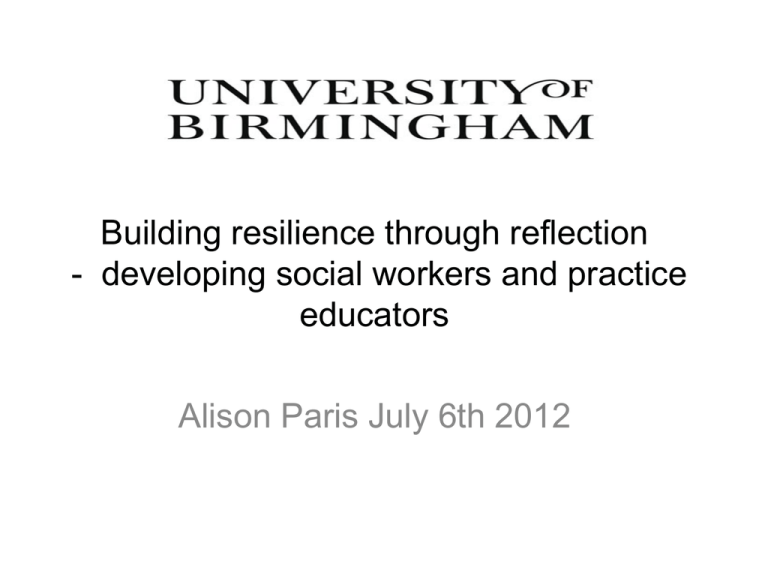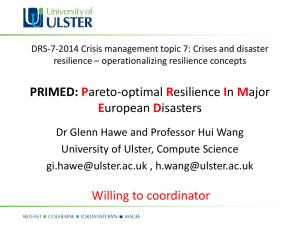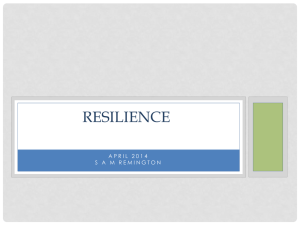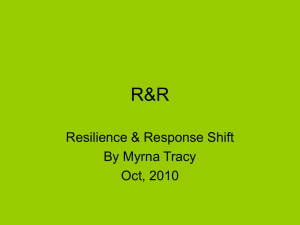Building resilience through reflection for developing social workers
advertisement

Building resilience through reflection - developing social workers and practice educators Alison Paris July 6th 2012 Welcome and Introductions! Aims of the Workshop. -To consider the significance of resilience awareness the conscious development of resilience for social work practitioners, trainee social workers, and their supervisors. To identify the themes in the Professional Capability Framework(PCF) which help us identify and apply a continuing developmental process with learning practitioners To identify and consider some connections with reflection To actively explore some principles and tools for supporting reflection and resilience building -To offer examples of tools, frameworks and approaches to use in supervision and other settings with self, students and qualified staff. I hope to ……. • • • • • • Consider some existing emerging themes concerning resilience and learning practitioners Make usable connections with the PCF Framework Offer examples of tools, frameworks and sequences for identifying our own and others’ resilience strengths and supervising reflectively for resilience Use ourselves - think about what some of the tools might mean for us Explore ideas for supervision and mentoring( having a go at one or two, if we have time!) Offer ideas to take with you to support students ,NQSWs( I have used the generic term ‘learner’ for wider applicability) staff and yourselves. Trying some ideas out…. • Your Pack Resilience Hunting equipment! We will use this. ……….To take with you….. • Your WRAP Social Work and resilience – some key research findings( Grant and Kinman 2010) • Social Workers gain considerable satisfaction form their work but report higher levels of work-related stress than many other occupational groups • Serious ongoing implications – a cumulative effect; longevity in social work practice averages at 8 years • Need to identify protective factors and to equip social workers with emotional skills and competences which can help protect against stress Linked insights ‘Salutogenisis’ (Antonovsky 1979: Becker ,CM ,Glas coff, M.A and Felts,W.M.( 2010) A protective process of ‘being’, allowing flourishing in the face of stress – reflects….. Sense of Coherence – the ability to comprehend the whole picture of the stressful situation and to marshall resources Generalised Resistance Resources(GRRs) - resources which keep the individual’s movement pro-health – physical, psychological, social and ecological Insights ctd • Awareness of own vulnerabilities and willingness to address these and take care of self ( Anderson and Burgess 2012) • Capacity to transfer that awareness to others and to support them • Capacity to learn skills and awarenesses that support and protect • Compassionate practice – with and in relation to self and others, • Compassionate practice – significantly expressed within the PCF range of areas Making professional links - the PCF– Your balance for compassionate practice – a sense of the whole person – (social worker and service user focus) Professionalism…in the context of Values and Ethics…. and Diversity…leading to an active awareness of Rights, Justice and Poverty..to champion which you bring your professional…… Knowledge….which you express through Intervention and Skills….. using which, you develop positive impact and increasing effectiveness through Critical Reflection and Analysis…in the setting of ,but supported by Contexts and Organisations…. through guidance and compliance ,but also through enacting your practice responsibilities proactively Professional Leadership Key points of connection – skills and awareness Meta-competences (Bogo 2010) underpinning ‘values in action’ involving use of skills to convey values /attitude within other broader skills and tasks. Could in a sense be called ‘meta-skills’ Emotional Intelligence( Awareness of , expression of and regulation of emotions in the context of professional relationships) Plus Empathy( Capacity to support ourselves compassionately and to enter into the experiences of others, while not over identifying with these) Plus Reflective Ability( Capacity to systematically build a our awareness of internal and external situations ;to test awarenesses and consider alternative approaches Capability statements concerning resilience • How they help us…. • By defining Resilience in the specific context of social work • By assisting learners to both understand and demonstrate resilience and is ingredients • Through a more holistic emphasis, to guide learners and educators towards connecting evidence and learning about resilience across the range of Capabilities • By offering a standard by which to discern strengths, areas of expertise, difficulties, areas of weakness, and contribute to the exploration of marginal capability(PEPS Domain C (14) • Marginal capability often reflects difficulties within ‘metacompetencies’ Differing Level Statements – all under ‘Professionalism’ – • Readiness to Practice: -Describe the importance of emotional resilience in social work End of First Placement: -Show awareness of own safety, health , well-being and emotional resilience and seek advice as necessary End of Final Placement -With support, take steps to manage and promote own safety, health , well being and emotional resilience ASYE -Develop ways to promote well-being at work, identifying strategies to protect and promote your own well being Experienced Social Worker -Recognise and seek ways to promote well-being for team and colleagues Defining Resilience Inevitably a construct: socially , culturally and psychologically and personally constructed: Definition = includes what is personally meaningful ‘ Bounce- backability! ‘Getting up , dusting down and starting all over again..’ ( Words from a Song) ‘We all know what resilience is until we try to define it’( Padesky 2009). Defining Resilience and its significance • ‘The process of, capacity for, or outcome of, successful adaptation despite challenging or threatening circumstances’( Masten et al 1990) ...A general capacity for flexible and resourceful adaptation to external and internal stressors’( Klohen (1996 ) cited in Kinman and Grant (2010) p..2) Importance for Student Social Workers - Gant and Kinman( 2010) - resilience themes • • • • • • • Reduction of ‘stress’ and ‘distress’ in social work students.( my terms).multiple stress contexts – the significance of learner stress and cross – institutional stress( also my terms) Social work students were both less distressed and stressed if… They were more Emotionally Intelligent – that is, able to show empathy but also having strong reflective capabilities (able to engage in- empathic reflection, reflective communication and self –reflection. If able to show empathy but were not so able to empathically reflect on self and other - greater tendency for stress and distress. Emotional Intelligence( including being able to undertake and engage in self - other reflection) =Resilience =Psychological health and well-being. Therefore better able to practise safely effectively and compassionately in organisations Therefore students need support to learn to reflect, and supervision that enable and builds reflective processes Importance for Newly Qualified Staff • • • • • • • • Concerns about stress resilience of newly qualified social workers Laming 2009 – need to develop ‘emotional resilience to manage challenges they will face( from Gant and Kinman 2010) Curriculum of knowledge for students and NQSWs tends to be contentdriven….. little focus on emotional management ( Morrison 2007) and building resilience Unfinished and complex nature of the social work( Tovey 2007) Need for enhanced capacity to deal with ‘reactions of the heart’( Gant and Kinman 2010) NQSWs still experiencing un – regulated caseloads,lack of supervision , or supervision which is focussed only on case management and lack of focus on their learning process. All currently made more difficult organisational cuts and ‘restructuring’ Knock on effect for more experienced staff . Positive Change and Resilience • Plasticity… • ‘….substantial psychological change …… is possible when a person’s environment changes’ • We are much more flexible than we think • Small positive changes in a social or psychological system ignite a ‘ripple effect’. Also moves from person to person – organisational impact • And Mindfulness …the more we become aware of small inner and outer influences we have and of how we can best influence, the stronger and more effective these become (Davis 1999) Gilbert (2008), Ryle ( 1991). Positive change ctd - Connecting with our own resilience energy – Identifying our strengths and establishing coherence ( a personal narrative of resilience) Defining energies in terms of strengths Reframing overcoming of difficulties as proof of Strength, Intelligence, Insight ,Creativity and Tenacity Moving us from deficit to ‘self-righting capacity’ (Werner and Smith 1982) Resilience for learning about and supporting practice ( Padesky 2009) • We all have within and outside ourselves a personal resilience ecology or set of interactions- resilience in one area can strengthen others • We can seek for and recognise our strengths systematically and positively and ‘transfer’ strengths to other areas • We can support each other in drawing out our resilience strengths • Resilience enables aware and focussed practice in challenging circumstances and underpins effective decision making • We model resilience awareness with colleagues and supervisees • By accessing and using our opportunities for ‘proactive resilience’ we influence both practice and organisations An Holistic Resilience Model ( Davis 1999) A framework for learning about resilience for trainee social workers(Reflecting Kinman and Grant 2010) • Building Awareness – what is resilience and what are our vulnerabilities • Building Empathy – compassionately but also honestly identifying key vulnerability and strengths components and what we can do about these - supporting ourselves and others • Building Emotional Intelligence – Understanding and seeking ways of managing own emotions and our professional relationships; seeking a positive and strengths – focused mindset • Building Reflective capacity - With others - opening up possibilities , testing with others and against relevant information and standards(PCF); linking inner and outer pictures, before and after experiences and underlying dynamics( power) Some ideas for working with trainee social workers and other learners A Possible Sequence • • • • Defining Resilience Building awareness Developing Empathy Developing Emotional Intelligence Way in(1) What’s resilience? • Identifying key words • Some ideas about what they mean to each of us • How can we each best interpret meanings so that we can most easily act on them( Remembering ‘Resilience’ as a construct) • Opening up Empathy and Emotional Intelligence in the interactive process involved (2) - Your life snake • Resilience ups and downs? Where do you feel you ‘bounced back’ and where not? What helped and hindered? Being systematic , practical and definite - Padesky (2009) – 4 stage model for Resilience building • Stage 1 -Identify strengths • Stage 2 – Construct a map of your resilience strengths • Stage 3 – Apply to other areas • Stage 4- Practice using (3) - Resilience Examples- Identify your resilience ideas in the windows…. (4)Resilience hunting • Your mission – to seek out resilience strengths with another person. • Do this by asking questions ( open) but also illiciting stories symbols, metaphor • Test assumptions about ‘failure’ • Can use drama and art ( see Anghel et al 2010- using drama and art to explore resilience strengths and skills a part of a social work qualifying programme) • Important : Must note specific strengths • Must form these into a profile of strengths • Important then to go and apply profile of strengths in different circumstances – rehearsing and strengthening skills (4) Identifying and Developing Your Strengths Profile • Strengths/Assumption Hunting and questionnaire (in your packs) • Working together using Resilience Hunting guide (in packs) Application (1)Lewin’s Forcefield How does the context in which we work and also live help us be more resilient? Pushing or constraining Pulling/encouraging or Application (2)Using resiliencies • How can we transfer our resiliencies to influence our context? YOUR RESILENCE ENERGY - FOCUSING ON WHAT YOU CAN INFLUENCE CIRCLES OF CONCERN & INFLUENCE Link •Identify concerns in Circle of Concerns •Identify areas of influence or strength in Circle of Influence •Pinpoint the links between areas of Influence and areas of Concern From Covey, R, 1992.Adapted Application (3)Building Meta-Skills Use • Identifying the ‘narrative’ behind a meta competence and skillfor example - Empathy • What does theory tell you about the skill? Identify the key ideas and particular connections between Feeling Things, Knowing things and Doing things; thinking about people we are working with – how would we put that mix into practice • How would you like to experience that skill – real situations • Actually putting it into practice( shadowing ,co-working, being observed) • Using a Reflective Log for skills development =- recording and reflecting on how he Knowing Doing and Feeling came in to action through using the skill – for you and for service users. • Testing out the narrative in Supervision Resilience is not all down to the individual • Shared responsibilities • 1. Supervision and Support • 2. Organisational culture and conditions The Social Work Reform Board - supervising the process of learning for practice - resilience forms part of this An holistic perspective on the professional role of the social worker and the notion of Continuing Professional Development A ‘balanced ‘concept of supervision accountability/developmental balance;process/structure connections Responsibilities of both organisation and individuals Emphasis on reflection( practising it, supporting practitioner development of it) which is transformative – not only in and on practice but critical( big picture, underlying dynamics) and reflexive( inner picture, self / professional dynamics) – not any old reflection! The Reflection Connection - What kind of reflection supports Resilience Building? Emphasis on: Specifically identifying personal , practical, professional and spiritual resilience strengths Incorporating feelings about task, role, process and self/other interactions Building up the learning process beyond surface (understanding facts/procedures) to deep (understanding and applying meanings/values) Links for use within the Supervision Process for development of students and practitioners A Reflective Supervision Process – Boud ,Keogh and Walker ( 1985) –motivating for resilience building • Emphasis on:• incorporating feelings • listening and clarification skills • Supervisor modelling Empathy and Emotional Intelligence • Building in learning • Working towards positive consolidation or change A MODEL OF REFLECTION FOR RESILIENCE AWARENESS IN THE SUPERVISION RELATIONSHIP (Boud et al 1985, Johns 1995) STAGE 1: RETURN TO EXPERIENCE • Describe the experience, recollect what happened • Notice what happened/how you felt/what you did SUPERVISION helps by: exploring discrepancies Using listening skills/asking questions, STAGE 2: ATTEND TO FEELINGS • Acknowledge negative feelings but don’t’ let them form a barrier • Work with positive outcomes SUPERVISION helps by: focus on positive outcome Exploring any barriers, supporting a STAGE 3: RE-EVALUATE THE EXPERIENCE • Connect ideas and feelings of the experience to those you had on reflection •Consider options and choices SUPERVISION helps by: choices Supporting connections/options and STAGE 4: LEARNING (ADDED BY JOHNS 1995) • • • How do I feel about this experience? Could I have dealt better with the situation? What have I learnt from this experience? SUPERVISION helps by: Encouraging learning, identifying strengths, encouraging use of strengths to make positive changes Boud, D.; Keogh, R.; Walker, D. (Eds) (1985) Reflection: turning experience into learning. London: Kogan Page Johns, C. (1995) Framing learning through reflection within Carper’s fundamental ways of knowing in nursing. Journal of Advanced Nursing 22(2) 226-234 Adapted: Alison Paris - University of Birmingham 2011 A professional presence –underpinning resilience development -Pro-Social Modelling ACTIVE RESPONSIVE ( A problem solving perspective – yes, you/I can!), (Listening, empathic , Small steps, action plan, visible outcomes for visible progress Caring but not collusion, behaviours and actions not judging people or attributing motivations) Pro-Social Principles Trotter 2002 MODELLING Cherry 2010 positive values and compassionate practice a ‘discourse of caring’(Bisman 2004) Professional reliability and accountability LEGITIMATE Affirming organisational ,team, and individual task and purpose Affirming accountability for ‘right focus’ and ‘best practice’ Moving the learner forward – Supporting resilience development (Morrison 2005) • From Red(Anxious) Cycle - Difficult experience; Reflection defended; Links to bigger and personal pictures reduced (unseen areas for both remain unseen); application in practice of new ideas undermined; learning from experience not captured • To • Green( Open ) Cycle – Difficult experience; Reflection supported and hence open; links to bigger picture and to personal input opened up ( unseen areas for both); Ready to apply new ideas in practice; Next experience more informed A Possible exercise • Consider a key practice issue a supervisee (student, or practitioner) might bring to you in supervision or for guidance, which has: • an emotive component • an element of actual or potential poor practice. How have you used or might you use the principles to ensure a learner moves or stays in the ‘Green Cycle’ ?What might they look like? Organisational culture and conditions: SWRB standards for employers of social workers - summary 1. Have in place a social worker accountability framework 2. Use effective workforce planning systems 3. Implement transparent systems to manage workload and case allocation 4. Ensure social workers have tools and resources to do their job safely and effectively 5. Ensure social workers have regular and appropriate social work supervision 6. Provide opportunities for continued professional development, research and practice guidance 7. Ensure social workers can maintain their registration 8. Establish effective partnerships with HEIs to support delivery of social workers education and continued professional development Considering your support - revisiting the resilience wheel( Tamsin Waterhouse 16.3.11) Resilience – Proactive about Well-being • • • • Prevention Links with ‘Salutogenesis’ Monitoring our well being Identifying triggers which might threaten well-being WRAP PLANNING- wellness recovery action plan ( Jane Thakoordin and Riffat Bashir- March 16th 2011 • Designed by a Service user group • WRAP - designed for learning about yourself, what helps and what doesn’t, and how to get progressively more in control of your life and your experience. It is a framework with which you can develop an effective approach to overcoming distressing symptoms, and unhelpful behaviour patterns. • Can this also be applied to students, staff members and teams? Creating your own WRAP - to take with you • What keeps me well? What are the triggers that I may be feeling (unwell, unhappy, overly stressed)? What can I do about them? How can I identify early warning signs? What is my action plan when things begin to go wrong? ……..this can be used in supervision with students, staff members and teams Picking up on the themes we have covered - Some questions for you to consider… • • • • • Is it helpful to place resilience as more centre stage in our work with students and developing staff? How can we focus on providing more of a Reflective Space and Compassionate presence in supervision? How can we use the PCF to assist students in understanding the contribution of resilience development to their professional development and practice? And for assessing their capacity for resilience in practice? Models, Connections, and Principles – what might be useful to you to adapt or create from? Any useful links? How could you use ideas about resilience with individuals and/or groups of: students/practitioners/managers/practice educators? Thank you • For your ideas, participation and comments







